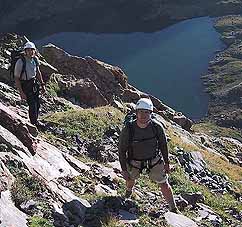
Copyright © 2002 by George I. Bell
[Click on any image for the full size version]
Nestled in the hard-to-reach Sangre de Cristo Range are what Gerry Roach calls two of the hardest of Colorado's Fourteeners: Crestone Peak and Crestone Needle. Due to its remoteness and difficulty, Crestone Needle was the last of Colorado's 14ers to be climbed. It was not until 1916 when Albert Ellingwood reached its summit after traversing from Crestone Peak. This complex half a mile traverse through exposed 3rd and 4th class terrain would in time become one of Colorado's four "Classic" traverses.

|
|
On easy ledges above the direct start
Copyright © 2002 by George I. Bell |
| Life is nothing more than the pursuit of stories worth telling to your children. |
| -Unknown |
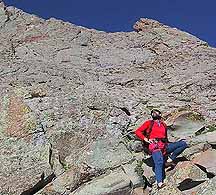
|
|
Looking up at the Red Tower from where the direct and normal starts join Copyright © 2002 by Mark Oveson |
We count no less than fifteen cars at the trailhead. Within minutes of our arrival, Mark is going from campsite to campsite courteously inquiring about their plans. We find one group that is planning to do the Ledges route. But we are uncomfortably aware that other folks attempting the route are probably spending the night at the base of the wall some 3 miles away from our campsite. We can't afford to be second on the wall if we want to top out in time to do the traverse. We turn in at 10PM for a night of vivid dreams at 11,000 ft.
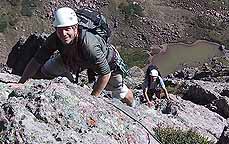
|
|
High on the route, simul-seconding on excellent conglomerate rock Copyright © 2002 by George I. Bell |
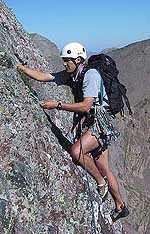
|
|
Warren leading the first headwall pitch
Copyright © 2002 by George I. Bell |
| ... There were pessimistic doubts expressed as to the last five hundred feet, where the precipice seemed to attain verticality, and near the top of which a huge boss of well-polished rock was certain to force us into an enormous overhang from which we could discern no avenue of escape. |
| -Albert Ellingwood, referring to the upper section of the Ellingwood Ledges route |
We carry one 60m rope and plan to simul-second the hard pitches and simul-climb the easy but technical ones, the rest will be done unroped. Mark disappears behind a bulge while George and I shiver silently, hoping for the "off belay" signal that will allow us to get moving and to warm up. We are rudely awakened from our trance by Mark's shout of "rock". I instinctively lean against the wall while George remains undisturbed looking up. A few seconds later a fist sized rock whizzes by some 15 feet from us. I mention to George that he didn't even move and he replies that he was trying to see where the rock was going. A few seconds go by and he laughs saying he couldn't even see it until it had passed. As George starts up, the party of two from the tent reaches the base of the wall. George greets them but it is clear that they are none too pleased to be second on the wall. They probably think that as a threesome we will be holding them back… We will not see them again that day.
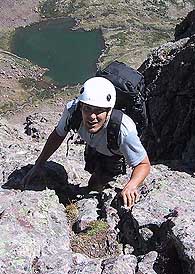
|
|
Warren a few feet below the top
Copyright © 2002 by George I. Bell |
A small headwall blocks our passage and a fixed piece on the right suckers us in that direction. Mark leads up to the fixed piece and it quickly becomes apparent that this is not the 5.4 section we are looking for. Mark reverses the moves and George leads up to the left on much easier terrain. His lead takes us to the base of the last three technical pitches. This is the famous headwall, the last 500 ft, where the route cleverly squeezes between a polished slab on the right and a huge brooding overhang on the left. In a long lead, I string up two of the pitches. We regroup and George leads the last technical pitch. We are doing the "right side" variation, a steep 5.7 dihedral. The position of these last three pitches is nothing short of amazing. Some of the best climbing I have ever done. I simul-second behind Mark, cleaning the crux pitch and breathing hard at 14,000 ft. Then, five hours after our start from the base, we unrope and proceed to scramble the last 100 ft up a small gully leading to the top.
| And now, ve dance ... |
| -Mike Myers as "Dieter" in "Sprockets". SNL. |
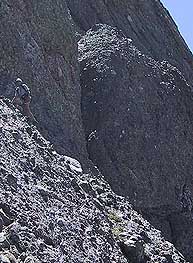
|
|
Solid, low angle knobs on the traverse (wild 3rd class!) Copyright © 2002 by George I. Bell |
I am incredibly happy to have completed the Ellingwood Ledges route. What a great climb, my best 50 Classic Climbs so far. But somehow, I can't savor this achievement fully. I am anxiously thinking about the traverse. I glance at it while I change my shoes and eat. It looks wicked from where I stand: The ridge is three feet wide, the drop-off to the North is more than a thousand feet, the drop off to the South is slightly less. Then after some thirty feet the ridge disappears. A sea of towers and gullies extend towards Crestone Peak. It looks as if there were too many features crammed into the half a mile separating these mountains. It is not clear at all which way to go. George looks for the rappel anchors that mark the start of the traverse. We cautiously reach the anchors at the end of the ridge as one of the Bud boys follows us at a distance and utters words of encouragement. The Part Deux of the adventure starts with a rap…
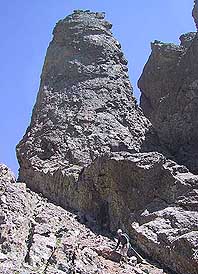
|
|
Mark traversing below the Black Gendarme
Copyright © 2002 by George I. Bell |
| Gather your fears and your possessions, whatever certainty you've know. Forget your heroes, you don't even need those last few lessons. Stand in the open, the next voice you hear will be your own |
| -Jackson Browne |
After a 100 ft rap we proceed to scramble some 400 feet of 3rd and 4th Class while pursuing a generally downward traverse. The exposure is mind boggling. A mistake here, a broken hold, would be final. I slow down and George and Mark have to wait on me on a couple of occasions. We finally reach one of the few recognizable features: The Black Gendarme. The saddle on the ridge at the base of the gendarme can't be more than a foot wide. We downclimb a constricted gully that ends in a ten foot cliff requiring some easy 5th class moves. Finally, we are on some comfortable ledges and cairns appear leading us towards the Red Couloir (this is the South face route up Crestone Peak). A mind-numbing traverse on ledges ensues. When we reach the Red Couloir we are about 800 vertical feet from the summit, we switch into auto-pilot and we work our way up.
Two hours after we started the traverse, we reach the summit of Crestone Peak. No party awaits us here, just a couple of people who nicely decide to leave when we get there. We have accomplished the second part of the challenge, we are really happy, but we still have to get down. By now, we are desperately short on water. The great weather that has allowed us to carry out our adventure, has also badly dehydrated us. The sun has been relentless and there are no clouds to provide relief. We decide to downclimb the South face route of the Peak since this is a safer route than the standard Northwest Couloir. The cost of safety: we will have to hike up broken hand pass to reach the trailhead, an additional 600+ vertical feet.
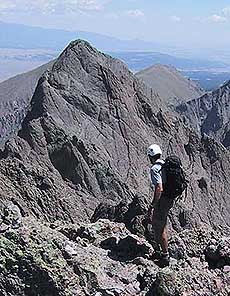
|
|
Starting down from the summit of Crestone Peak, Needle behind Copyright © 2002 by George I. Bell |
| Well I'm, near the end and I just ain't got the time, oh yeah. And am wasted and I can't find my way home… |
| -Steve Windwood, Traffic |
We painfully work our way down the Red Couloir, we are to lose some two thousand vertical feet this way. Due to its Southern exposure the sun is baking us. We are nine hours into our day and the wear is starting to show. Near the bottom we try to contour towards the pass to save us some distance but we get cliffed-out. Back to following the cairns, they are there for a reason. Then a breakthrough, Mark spots a small stream, more like a trickle. It is trickling from the rock above us and forming a small pool no more than 3 feet wide and six inches deep. The water is crystal clear and cold. George and I use chemicals to treat it and have to wait an agonizing half hour until the water is cleansed, Mark decides to take his chances and downs a quart almost immediately.
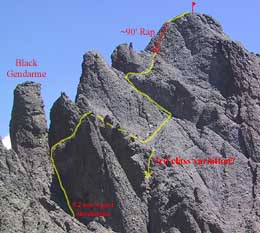
|
|
Crestone Needle, showing the traverse line. Click for full size image and more info. Copyright © 2002 by George I. Bell |
On the drive back, just as we exit the 4x4 road, I mention to Mark that it feels like we have been here for a week. He agrees and after checking his watch he points out we have been here less than 24 hours. After a pause, he smiles at me and says: "we blitzed the Crestones".